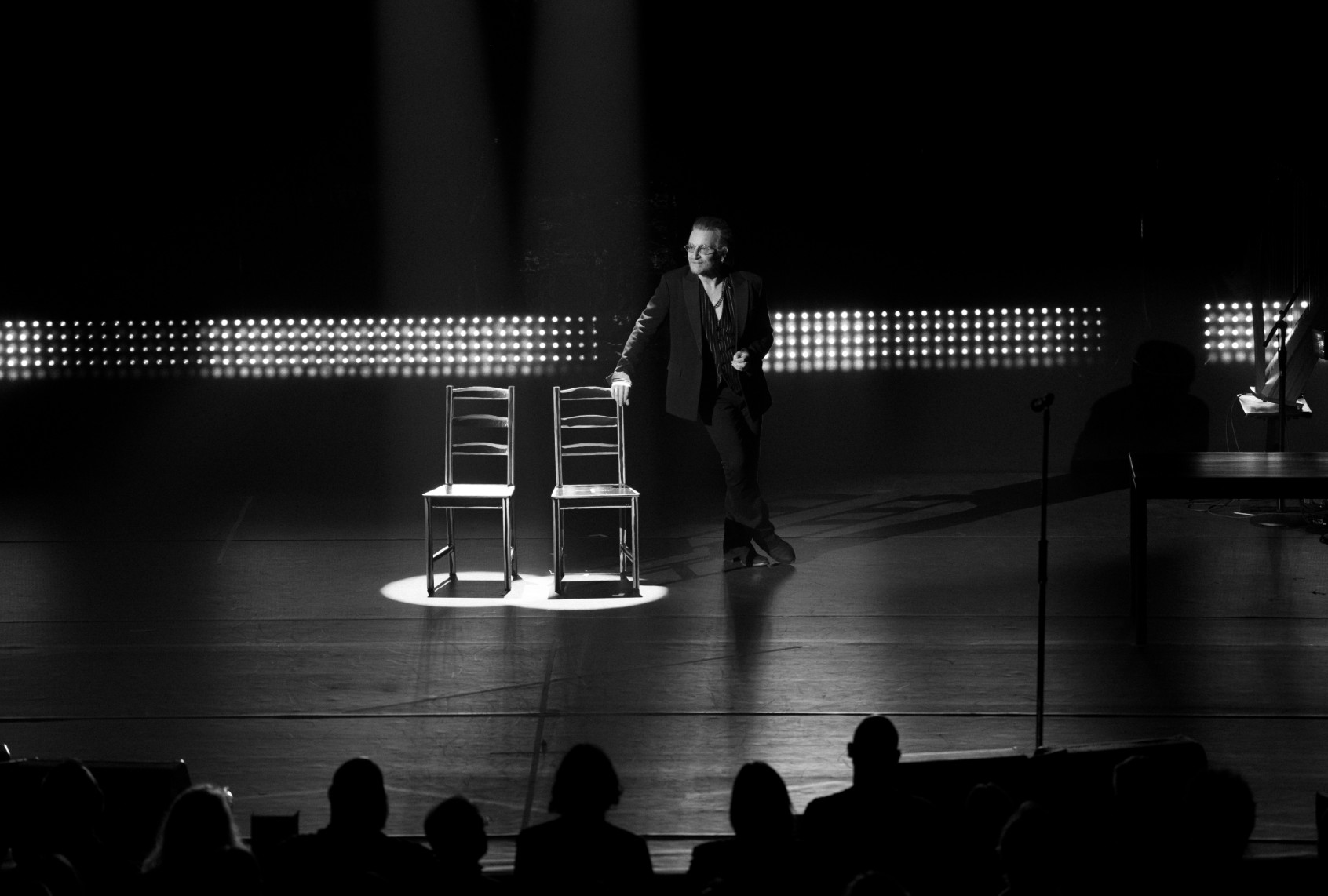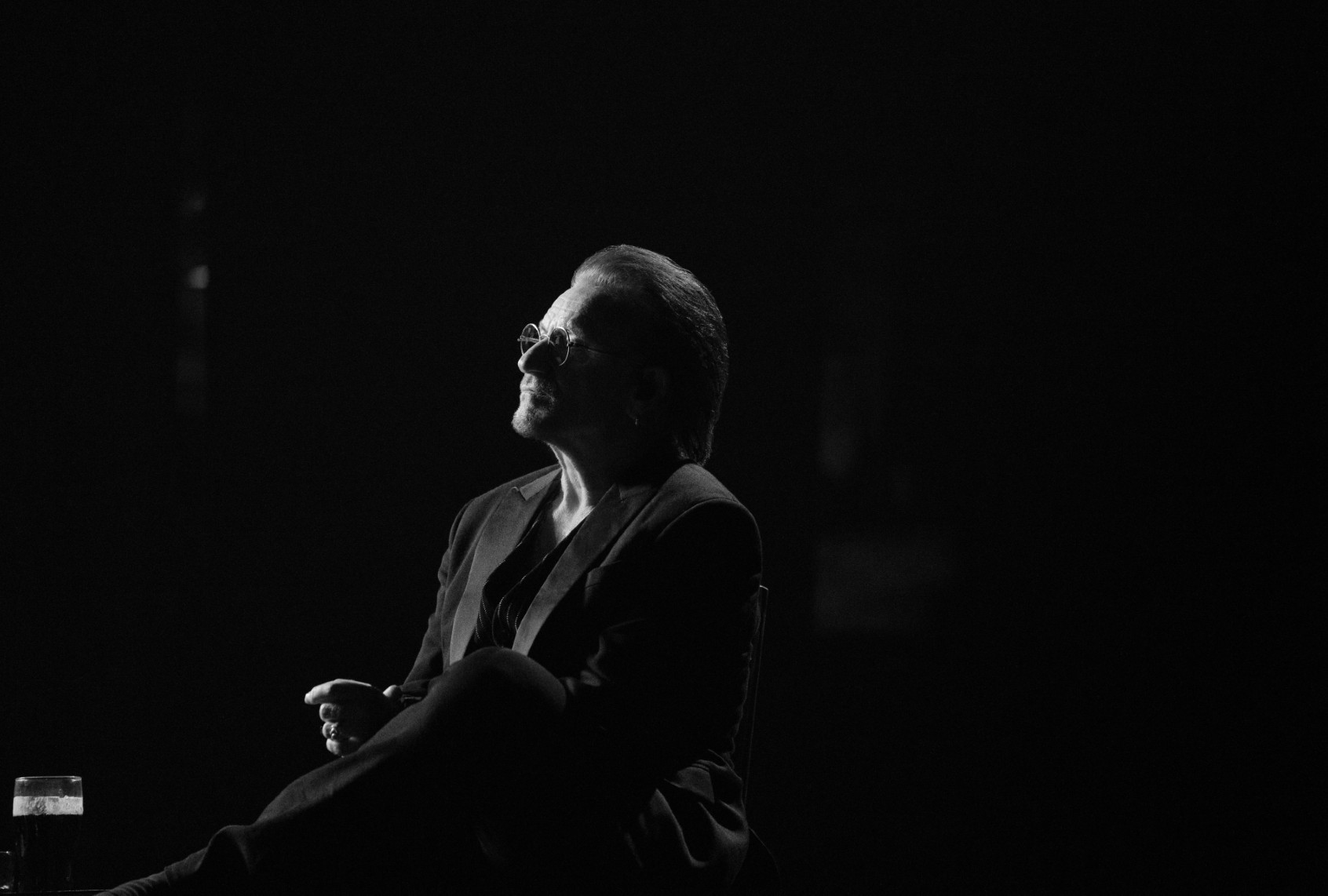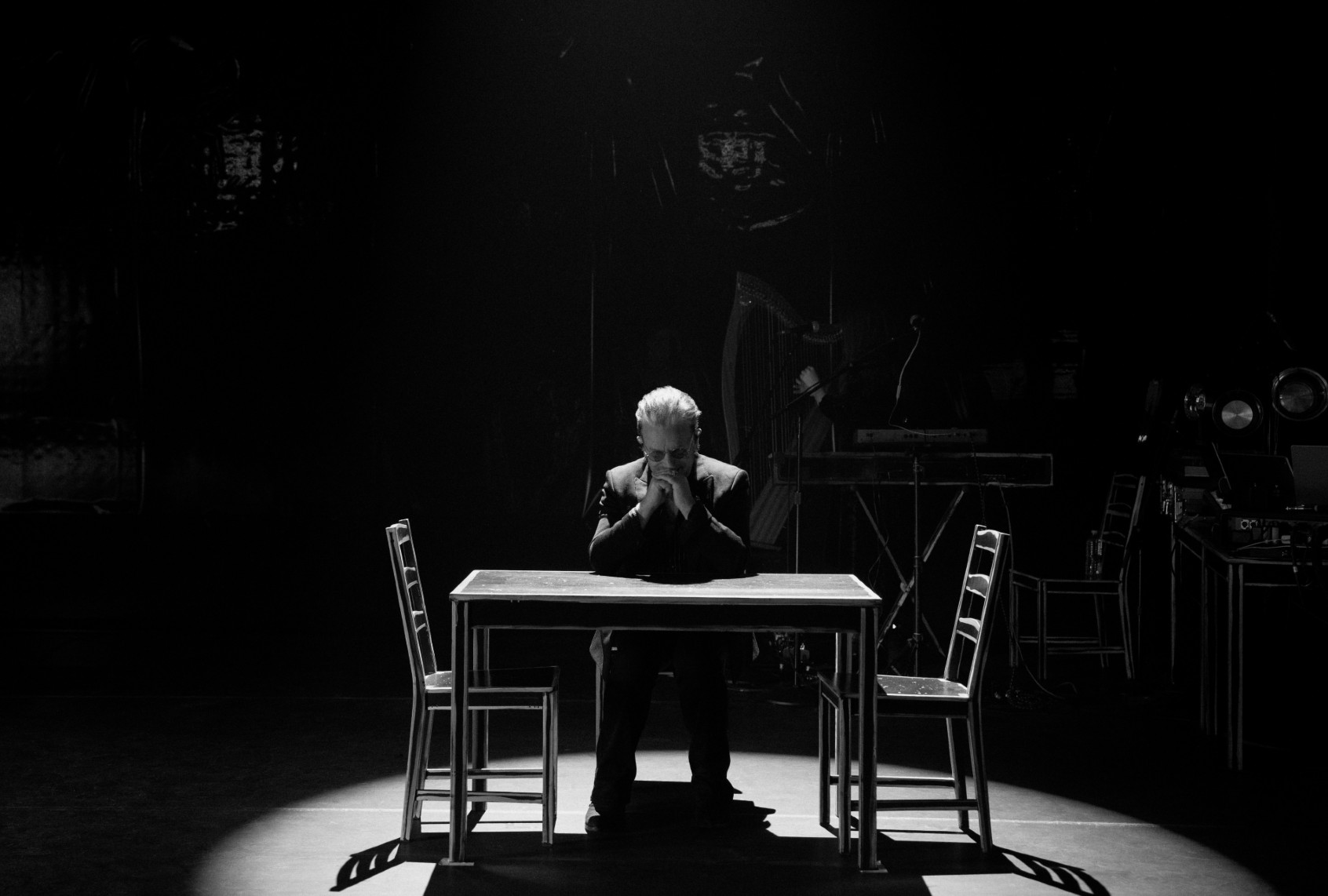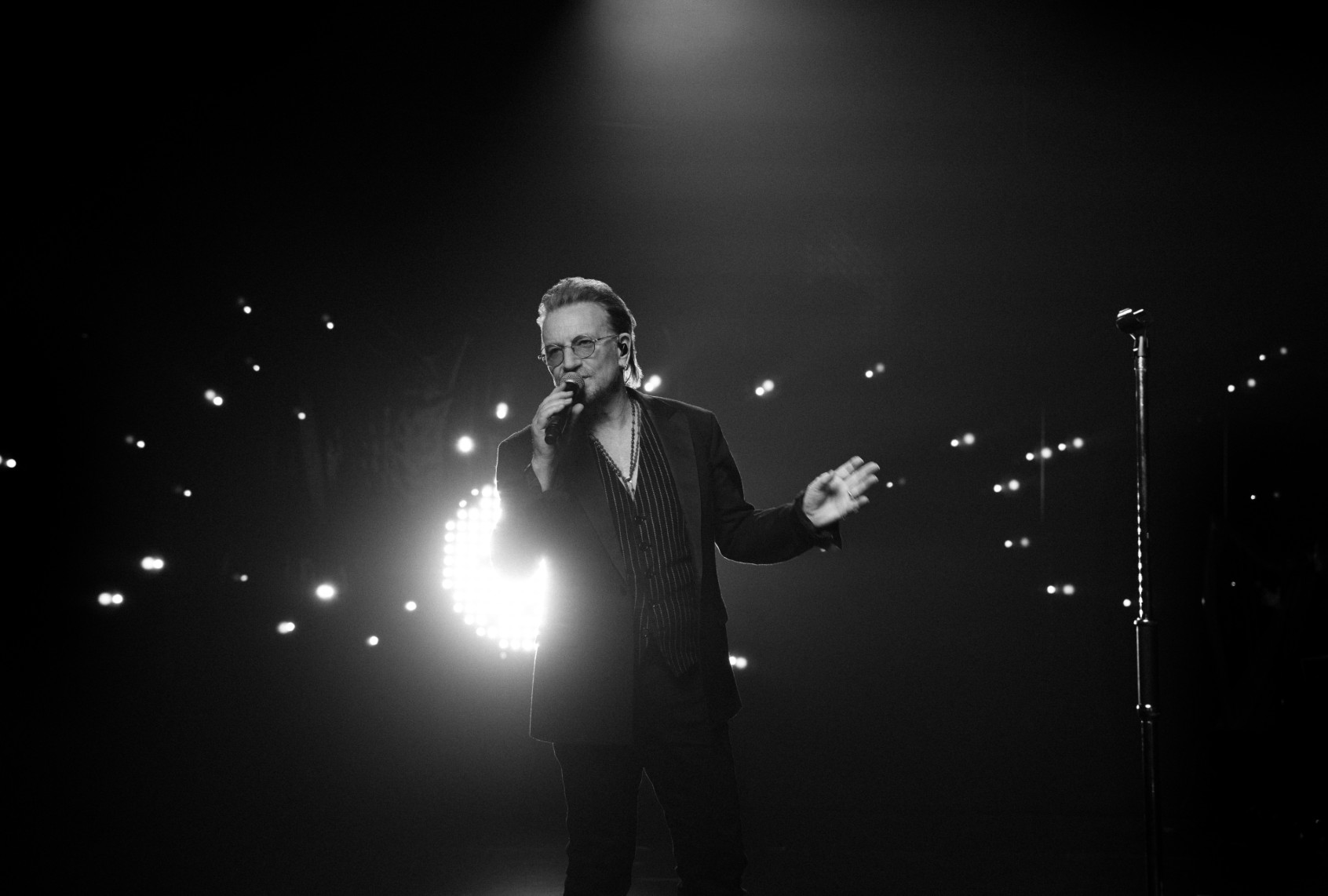“I’m still pretending this is a book tour,” Bono says shortly into “Stories of Surrender,” the new film on Apple TV+. He’s just shared the story of his “eccentric heart” and the non-trivial health scare he went through around 2015, and then taken the crowd into a quasi-acoustic rendition of U2’s “Vertigo,” accompanied not by guitar, bass and drums but rather some electronic percussion and a cello. The audience roars in recognition of the song’s opening riff, played on different strings; they don’t have to be asked twice to provide the Edge’s responses (“Hola!” and “Donde esta?” respectively).
Following the release of his 2022 memoir “Surrender,” U2’s frontman appeared in a short series of promotional dates in small theaters in the U.S. and abroad. If this event didn’t come to your city, you missed that this was even happening, or perhaps thought that the ticket prices were rather high for what was — at least originally — billed as book promo, you can now experience a version of what your host terms “a quarter-man show” from the comfort of your living room.
This film is a tribute to what you can accomplish with the power of suggestion, excellent lighting, sharp editing and a charismatic storyteller. But “Stories of Surrender” isn’t a traditional documentary, and it isn’t a concert film, either. The stories told in the film are shuffled, edited, and distilled from their original presentation. The cameras are placed everywhere but in the audience looking at the stage. They are in front of Bono, they are behind him, above him, beside him as he walks from the dressing room to the stage, showing his viewpoint of his father in their weekly chats at Bono’s local pub. Some segments are filmed live, some are not; it honestly doesn’t matter — it’s not a documentary.
It probably should not have been surprising that the lead singer of the band that toured with a motorized mirrorball lemon large enough for all four band members to comfortably fit inside wasn’t going to go on the road and do a run-of-the-mill “book tour.” There were some initial conventional types of appearances (like at the New Yorker festival), but if there’s one thing Bono does not require, it’s for someone to drag information out of him. A “conversation partner” would mostly get in the way. This format solves that problem.
 Bono in “Bono: Stories of Surrender” (Apple TV+)
Bono in “Bono: Stories of Surrender” (Apple TV+)
“Surrender,” the book behind this project, is 557 pages long, 40 chapters (the subtitle is “40 songs, one story”) and this isn’t intended to be a book review, but let’s just say that the “40 songs” statement is less of an outline and more of a loose organizational concept. None of that matters here; you don’t need to have read the book to watch the film. Great songwriting is about compression, and the element of subtraction distills what Bono clearly considers to be the most important elements of his life into 90 minutes.
The film is about the beats, the themes, the threading of the stories through time and across decades, and what’s particularly artful about the storytelling in this movie is the interconnectivity of the tales. Creating a film out of the events that were selected as part of the “book tour” performances had to be a challenge. That’s because the people who will spend money on a book event are the already-converted, fans who know the stories and the legends. But the film has to make the people outside of that large and multinational group care.
Great songwriting is about compression, and the element of subtraction distills what Bono clearly considers to be the most important elements of his life into 90 minutes.
U2 audiences already attract surprisingly large numbers of what could be referred to as “the Bono-curious,” people who might know the hits but probably don’t know who else is in the band (to be fair, Pavarotti didn’t either, as Bono relates). But what the film does very well is give the viewer enough information in order to follow along without overwhelming them with detail. It also reveals that Bono is a fairly decent impersonator, and although those moments are funny, they are not the best moments in the show.
Start your day with essential news from Salon. Sign up for our free morning newsletter, Crash Course.
The best moments are, perhaps unsurprisingly, when Bono is talking about music, whether it’s the explosive, life-changing moment he discovered the Ramones, or the early days of his own band. The segment leading up to “I Will Follow” describes what it was like when a young Bono, desperate to be good at something he loved, attempted to explain his ideas to his bandmates. His portrayal of the frustration of fearing that they weren’t good enough is one of the best moments of the whole night.
He’s set it up perfectly — he’s described his home life after the death of his mother, Iris, when he was 14; he’s explained how he met all of the members of U2 the same week he met his future wife, Ali; and then, he takes the viewers to the inside of the shed they used as a rehearsal studio, and walks you through his memory of what happened. You feel the tension and the emotion, and it’s raw and primal — even if you are someone who only casually pays attention to U2, it’s hard not to be moved by it.
 Bono in “Bono: Stories of Surrender” (Apple TV+)
Bono in “Bono: Stories of Surrender” (Apple TV+)
This vignette plays the unmistakable opening riff of “I Will Follow” at full volume through the PA, and Bono fakes the audience into thinking that he’s about to launch into the song. The crowd is reacting to what’s probably muscle memory derived from decades of being in the audience and hearing that sound. But then he stops it cold, and he apologizes to his absent bandmates. It’s almost more powerful than the segments where he does sing. You feel the undeniable power of the moment even through the screen.
“Stories of Surrender” has about a dozen U2 songs scattered through it, delivered in somewhat abridged versions, performed by a trio of musicians: Kate Ellis (cello, backing vox), Gemma Doherty (harp, keys, backing vox) and producer Jacknife Lee (who’s worked with U2 previously) on keyboards and percussion.
This accompaniment to Bono’s vocals is minimalist, slightly askew; female harmonies (or even lead vocals) on U2 songs are initially a little disorienting, and then it makes sense. He explains, early on, that it feels “somewhat transgressivo” (sic) to be appearing before them without his bandmates. So he’s deliberately not trying to duplicate U2, he’s attempting to distill a song to its essence to make a point, and he’s also making absolutely sure that he doesn’t even accidentally end up doing some kind of U2 karaoke.
It isn’t 100% successful; for example, the rendition of “Beautiful Day” feels dangerously close to William Shatner doing “Rocketman.” There’s a Stories of Surrender EP with three of the reconstructed numbers, but out in the wild on their own, they don’t hold up quite as well without the scaffolding of the show. But this format also showcases the strength of the songs when they’re stripped down to their bones, and also proves beyond the shadow of a doubt that the lead singer standing before you can actually sing, a point of contention that arises in multiple points as the evening unfolds.
He’s deliberately not trying to duplicate U2, he’s attempting to distill a song to its essence to make a point, and he’s also making absolutely sure that he doesn’t even accidentally end up doing some kind of U2 karaoke.
But the songs here are in service of the stories, and not the other way around. By comparison, “Springsteen on Broadway” — not exactly analogous, but we do not yet have a lot of one-man Broadway shows from rock stars so let’s work with what we have — was all about the songs, and the stories were the method by which Springsteen routed the audience from song to song. The other obvious difference is that — as Bono points out — everyone thinks that he is the leader of U2, when in fact every member of the band thinks they are the one in charge. Bruce Springsteen does not have to solve this dilemma and placate anyone except himself.
The stage show was, as usual, produced by U2’s usual co-conspirators (Willie Williams, Gavin Friday, among others), but the film was directed by Andrew Dominik, who music fans will be familiar with if you are a fan of Nick Cave. In that case, you might recognize some of Dominik’s visual language here, but only in the most general sense — and, again, not a criticism, film directors have their own ways of seeing that you come to recognize.
It is, however, different from the visual language that U2 fans are accustomed to seeing. U2 have actual giants working for them in that regard, people who have been working and evolving with them over decades, so it is, in some ways, revelatory to see the songs and words processed through another set of eyes. This further aligns with what seems like the mission of this project being Bono’s and featuring U2’s general cosmology, but it isn’t a U2 project. So the visual differentiation is important, but probably not accidental.
Another major difference between seeing the live event and the film is that “Stories of Surrender” is shot in black and white. That ends up being a superb choice for many reasons: it emphasizes that this is a piece of art that is adjacent to the performance but is not a carbon copy; it directs the viewer’s focus more intensely; it allows you to do a lot with lighting in terms of drama and separation without making it look like you’re putting on a show. It also seems like filming it in black and white makes certain elements — like the table and chairs Bono sits (and stands) on — less complicated, in a “limitations are freeing” kind of way.
 Bono in “Bono: Stories of Surrender” (Apple TV+)
Bono in “Bono: Stories of Surrender” (Apple TV+)
While the stories weave and interconnect throughout the night, the main thread that Bono continues to pull at is his relationship with his father, Bob Hewson. It’s not an unusual motivator in the history of rock and roll, and he certainly doesn’t pretend that he’s unique in that regard. The device of an empty chair representing an individual reoccurs: his wife, Ali; the four members of U2; an empty chair with a small table between them standing in for Sundays at the pub with his Da. Bob Hewson’s favorite question was, “Anything strange or startling?”
As Bono explains: “My father was a tenor, a really, really, good one; he could move people with his singing.” Bono, on the other hand, was “a baritone trying to be a tenor,” something his father repeatedly reminded him. Fans will probably already know the story of how, after Bob Hewson’s death, his voice had an entirely new range. “When you lose someone you love, they bequeath you something, a gift.” The loss of his mother propelled him into rock and roll and its gift of the love of an audience; his father’s passing somehow unlocked the vocal range he’d always wanted.
We need your help to stay independent
But it’s what happens next that’s actually astonishing. He mentions that his father also left him a song he was fond of, an Italian classic — Pavarotti performed it, among many, many others — called “Torna a Surriento.” It plays softly in the background, and then Bono sings it, solo, a cappella. It is a stretch, it is a dare, it is bold, it is brave, it is thrilling. The closing shot is Bono singing onstage at the Beacon, then cutting into Bono singing onstage at the stunningly opulent Teatro San Carlo in Naples, Italy, the audience leaping to their feet, before the camera rises up above the theater and the city skyline to a view of the Gulf of Naples and of Sorrento across it in the distance, spirits rising.
During the first run of “book tour” dates, there was some murmuring amongst U2 fans that this felt like they could possibly have been pilot excursions for Bono. Was this a way for him to test the waters and see how he liked the concept of the one-man show as a form he could utilize beyond book promotion while the band waited to see what happened with regards to drummer Larry Mullen Jr.’s health? As we now know, that conflict would be resolved by Mullen “deputizing” Bram van den Berg to take his place for the duration of U2’s Sphere residency in 2023-24.
But if nothing else, “Stories of Surrender” is a strong enough proof of concept to support the idea of a future “Bono On Broadway,” whether in a similar hiatus or at a point in which standing onstage in front of tens of thousands of screaming fans is no longer an attractive option.


